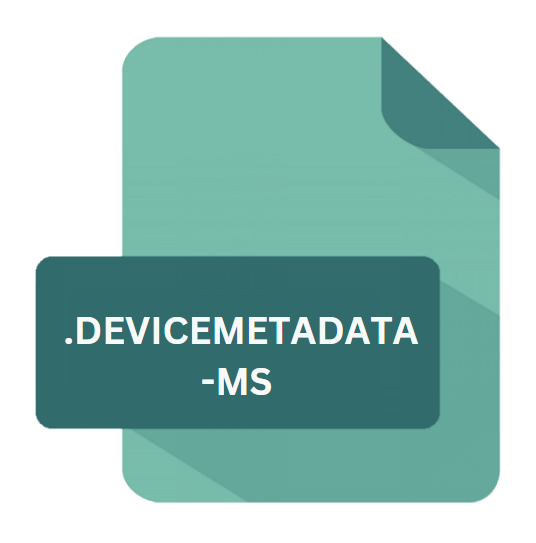.DEVICEMETADATA-MS File Extension

Device Metadata Package
| Developer | Microsoft |
| Popularity | |
| Category | System Files |
| Format | .DEVICEMETADATA-MS |
| Cross Platform | Update Soon |
What is an DEVICEMETADATA-MS file?
A .DEVICEMETADATA-MS file is a component of a device metadata package in Windows. Device metadata packages are collections of files that contain information about a hardware device, such as drivers, configuration settings, and user interfaces.
These packages help Windows identify, configure, and interact with hardware devices, ensuring that they function correctly and provide a seamless user experience.
The .DEVICEMETADATA-MS file specifically contains metadata related to the device, including descriptive details and configuration options.
This file is part of a broader set of files that make up a device metadata package, which typically includes .inf files (driver installation files), .cat files (catalog files for driver verification), and various resources like images and documentation.
More Information.
The concept of device metadata packages was first introduced with Windows Vista, which aimed to improve device management and compatibility.
These packages were designed to provide detailed information about devices, such as their capabilities, configuration options, and visual elements, making it easier for users to interact with their hardware.
Initially, the purpose of device metadata packages was to enhance the user experience by providing rich metadata for devices.
This included detailed descriptions, icons, and configuration options that could be presented in the Windows Device Manager or other device-related interfaces.
Over time, the use of device metadata packages expanded to include support for additional features and improvements in device management.
Origin Of This File.
The .DEVICEMETADATA-MS file extension originated with the introduction of device metadata packages in Windows operating systems.
These packages were introduced to enhance the support and management of hardware devices, particularly as the variety and complexity of hardware grew.
The need for a standardized way to provide detailed device information and configuration options led to the development of device metadata packages and, by extension, the .DEVICEMETADATA-MS file.
The development of device metadata packages was driven by Microsoft’s goal to improve the plug-and-play experience for users.
By providing detailed metadata about devices, Windows could better handle device installations, updates, and configurations, leading to a more efficient and user-friendly operating system.
File Structure Technical Specification.
A .DEVICEMETADATA-MS file is typically a compressed file that contains metadata in XML format. The file structure usually includes:
- XML Metadata: The core of the .DEVICEMETADATA-MS file is an XML document that contains detailed information about the device. This includes device names, descriptions, and configuration options.
- Resources: In addition to XML metadata, the file may contain various resources such as images or additional configuration files that support the metadata.
- Compression: The .DEVICEMETADATA-MS file is often compressed using standard compression methods to reduce its size and facilitate efficient storage and transmission.
The technical specifications of the .DEVICEMETADATA-MS file ensure that it integrates seamlessly with the Windows operating system. The XML format allows for flexible and extensible metadata, while the compression helps manage file size and performance.
How to Convert the File?
The .DEVICEMETADATA-MS file is not typically converted to other formats. Instead, it is used as-is within the context of device metadata packages.
If you need to work with or modify the contents of a .DEVICEMETADATA-MS file, you might use tools designed for handling XML files or device metadata packages.
For developers and advanced users, tools like the Windows Device Metadata Tools or specialized XML editors can be used to view and edit the metadata contained in these files.
It is crucial to ensure that any modifications do not disrupt the functionality or compatibility of the device metadata package.
Advantages And Disadvantages.
Advantages:
- Enhanced Device Management: The .DEVICEMETADATA-MS file provides detailed information about devices, improving the management and configuration of hardware in Windows.
- Improved User Experience: By including rich metadata, such as descriptive text and icons, the file enhances the user interface, making it easier for users to interact with their devices.
- Standardization: Device metadata packages provide a standardized way to deliver device information, ensuring consistency and compatibility across different hardware and Windows versions.
Disadvantages:
- Compatibility Issues: Although designed for Windows, .DEVICEMETADATA-MS files may not be compatible with older versions of the operating system or with non-Windows environments.
- Complexity: The structure and content of device metadata packages can be complex, making it challenging for users to modify or troubleshoot issues related to these files.
- Potential for Errors: Incorrect or corrupted metadata can lead to issues with device functionality, requiring troubleshooting and potentially impacting system performance.
How to Open DEVICEMETADATA-MS?
Open In Windows
- .DEVICEMETADATA-MS files are primarily used and opened within Windows operating systems. They are integrated into the device management infrastructure and are typically handled automatically by the system. To view or edit these files, you can use tools like the Device Metadata Retrieval Tool (DMetadataTool) or XML editors.
Open In Linux
- .DEVICEMETADATA-MS files are not natively supported on Linux. However, you can use generic XML editors to view the XML content of the file. For advanced manipulation, additional tools or custom scripts may be required.
Open In MAC
- Similar to Linux, macOS does not natively support .DEVICEMETADATA-MS files. XML editors can be used to view the contents, but interaction with these files in a macOS environment is limited.











